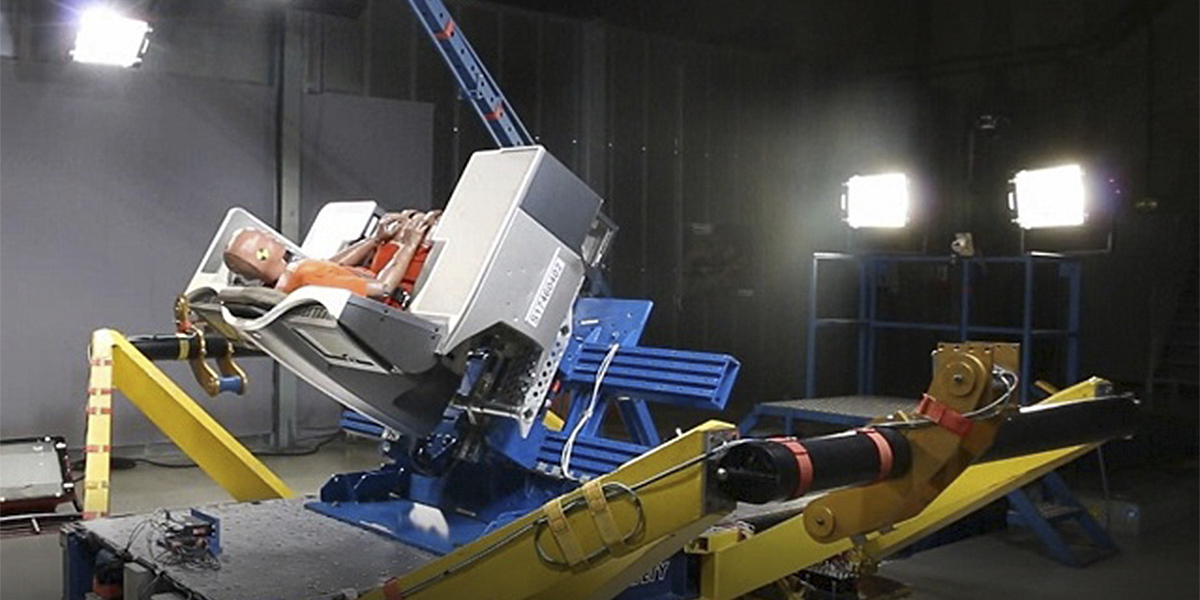FMVSS 202 Head Restraint Performance Testing
Federal Motor Vehicle Safety Standard (FMVSS) 202, titled “Head Restraints”, mandates that all passenger vehicles manufactured and sold in the United States must meet stringent performance requirements. This standard aims to ensure that head restraints provide adequate protection during rear impact collisions by minimizing the risk of whiplash injury.
The FMVSS 202 test evaluates the structural integrity, load distribution, and dynamic behavior of head restraints when subjected to simulated rear-end crashes. The test is conducted using a sophisticated crash testing apparatus that simulates real-world accident scenarios with precise control over impact velocity, angle, and duration.
The testing process involves several key steps:
- Preparation of the vehicle: The target area for the test must be carefully selected to ensure accurate measurement of restraint performance.
- Installation of the test dummy: A standardized anthropomorphic test dummy (ATD) is placed in the driver’s seat, with the head positioned directly behind the head restraint being tested.
- Application of impact forces: The crash sled is accelerated towards the vehicle at a predetermined speed to replicate the force experienced during a rear-end collision.
- Data acquisition and analysis: Sensors embedded within the dummy measure displacement, acceleration, and load distribution across various points on the head restraint. These data are then analyzed against FMVSS 202 criteria to determine compliance.
FMVSS 202 specifies that a compliant head restraint should limit the maximum vertical displacement of the dummy’s head under specified conditions, thereby reducing the likelihood of injury during an accident. Compliance is determined by comparing measured values against predefined thresholds outlined in the standard.
| Test Parameter | Description | Standard Requirement |
|---|---|---|
| Vertical Displacement | The maximum vertical displacement of the dummy’s head. | ≤ 1.5 inches (38 mm) |
| Load Distribution | The distribution of load across different sections of the restraint. | Must be within ±20% of expected values |
In addition to these quantitative measures, visual inspections are conducted to assess any visible damage or deformation in the head restraint that could affect its performance. Compliance with FMVSS 202 is crucial for manufacturers aiming to meet regulatory requirements and ensure passenger safety.
Why It Matters
The FMVSS 202 standard plays a critical role in enhancing vehicle safety by addressing one of the most common causes of injury during rear-end collisions: whiplash. By ensuring that head restraints perform as intended, manufacturers can significantly reduce the risk of neck injuries and associated medical costs.
Compliance with FMVSS 202 is not only a legal requirement but also an important factor in maintaining consumer trust and brand reputation. Consumers expect vehicles to meet rigorous safety standards, and non-compliance can lead to negative publicity, recalls, and potential legal action.
From a broader perspective, the implementation of FMVSS 202 contributes to safer roads by reducing the number of injuries resulting from rear-end collisions. This aligns with global efforts to improve road safety and promote healthier communities.
Industry Applications
- Automotive manufacturers: Ensuring compliance with FMVSS 202 is essential for meeting regulatory requirements and maintaining a safe product offering.
- Suppliers of safety components: Suppliers must ensure that their head restraint products meet the stringent performance criteria set forth by FMVSS 202.
FMVSS 202 testing is particularly relevant for:
- New vehicle models entering the U.S. market
- Revised or updated head restraint designs being introduced to existing vehicle lines
This testing ensures that all vehicles comply with FMVSS 202, thereby protecting passengers and contributing to overall road safety.
Eurolab Advantages
At Eurolab, we pride ourselves on providing comprehensive and accurate FMVSS 202 head restraint performance testing services. Our state-of-the-art laboratory facilities are equipped with the latest technology to ensure precise and reliable test results.
- Precision instrumentation: Our crash sleds and sensors provide highly accurate measurements of impact forces, displacement, and load distribution.
- Standardized protocols: We follow strict ASTM and ISO guidelines to ensure consistent and repeatable test results.
- Comprehensive reporting: Our reports include detailed analysis and comparisons against FMVSS 202 criteria, ensuring a thorough understanding of the testing outcomes.
We understand that compliance with FMVSS 202 is critical for your business. At Eurolab, we offer flexible testing schedules to accommodate your project timelines while maintaining the highest standards of accuracy and reliability.





